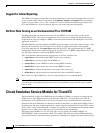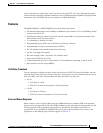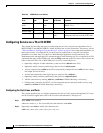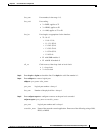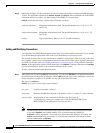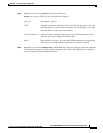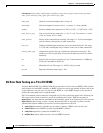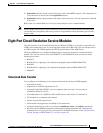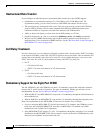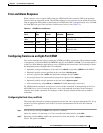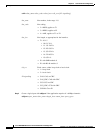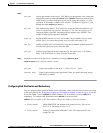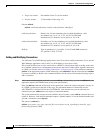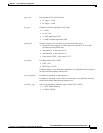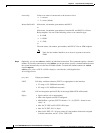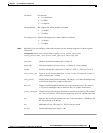
6-52
Cisco MGX 8850 Multiservice Switch Installation and Configuration
Release 1.1.31, Part Number 78-11223-03 Rev. B0, May 2005
Chapter 6 Card and Service Configuration
Eight-Port Circuit Emulation Service Modules
Unstructured Data Transfer
If you configure an individual port for unstructured data transfer, the 8-port CESM supports
• Synchronous or asynchronous timing at T1 (1.544 Mbps) or E1 (2.048 Mbps) rates. For
asynchronous timing, you can select its basis as either SRTS and adaptive clock recovery.
• The special port type framingOnVcDisconnect. This port type prevents a remote-end CPE from
going to LOF by placing a line in remote loopback mode when the CESM determines that a
connection deletion or suspension occurred at the network-side ATM interface.
• Ability to detect and display a yellow alarm for the ESF framing on a T1 line.
• Loopback diagnostics on a line or a connection (addlnloop, tstcon, and tstdelay commands).
• Bit error rate test (BERT) functionality with loopback pattern generation and verification on
individual lines. For a description of BERT functions, see the “Bit Error Rate Testing Through an
MGX-SRM-3T3” section on page 6-63.
Cell Delay Treatment
For each connection, you can configure a tolerable variation in the cell arrival time (CDVT) according
to the expected reliability of the route. The CDVT applies to the receive buffer. After an underrun, the
receiver places the contents of the first cell to arrive in a receive buffer then plays it out at least one
CDVT value later. For each VC, the maximum cell delay and CDVT (or jitter) are:
• For T1
–
Cell delay of 48 msec
–
CDVT of 24 msec in increments of 125 microseconds
• For E1
–
Cell delay of 64 msec
–
CDVT of 32 msec in increments of 125 microseconds
Redundancy Support for the Eight-Port CESM
The AX-CESM-8T1 and AX-CESM-8E1 can have 1:N redundancy support but with some variations
between the T1 and E1 modes of operation. The type of redundancy and the type of back card are
interdependent. See the “Service Resource Module” section on page 6-60.
• With an RJ48-8T1, an MGX-SRM-3T3 can provide 1:N redundancy through the distribution bus or
the redundancy bus.
• With an RJ48-8E1, an MGX-SRM-3T3 can provide 1:N redundancy through the redundancy bus.
Back card requirements for the MGX-SRM-3T3 and service modules vary, as follows:
• If you are using the MGX-SRM-3T3 for bulk distribution of T1 channels, the CESMs do not use
back cards, but each MGX-SRM-3T3/C must have an MGX-BNC-3T3-M back card. (Bulk
distribution is not available for E1 operation.)
• If the MGX-SRM-3T3/C supports T1 or E1 1:N redundancy through the redundancy bus (no bulk
distribution), the MGX-SRM-3T3/C does not require a back card, but the N CESM primary cards
must have one redundant version of the back card.



